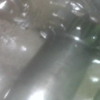@Cartod wrote: "What kind of job is it to pull the transmission?"
To get the transaxle out, you have to start by removing the engine:
Get the car up on jack stands and disconnect the battery.
Remove the fuel hoses and electrical wires
Remove the big, lower pipes from the heater boxes.
Remove the four bolts holding the engine to the transmission at the bellhousing
Then slide it back about 6"-8" and then let it down. All that takes about 90 minutes or so.
It helps to use a roll-around motorcycle jack because the jack holds the engine more-or-less level coming out or going back in. Once it's lowered down, you'll have to tilt the engine back so that the alternator/fan housing clears the body unless you have a lift, then just raise the car up to clear the engine.
Once the engine is out, then the next step depends on whether it is a swing-arm or IRS rear suspension. For Swing arm you need to disconnect the e-brake cables and brake lines at the brake drum/disk and take everything out as a unit. For IRS, simply remove the drive axles and leave the drums/disks in place.
Disconnect the shift rod coupler in the central tunnel, disconnect the back-up light switch wire, remove the mount bolts at the nose cone (front) end of the transaxle, support it with a jack and remove the two big bolts at the bellhousing, then lower it down and out. That's another 30 minutes or so.
I may have missed something, but you get the idea. It helps greatly if you have a lift.
If you pull it, you could check inside the nosecone housing to see if anything is broken, like the selector (it looks like a hockey stick and is a weak point). If everything looks OK, then it's time to visit a repair shop.
Your profile says you're in West Virginia so maybe @Alan Merklin can recommend a transaxle shop in your area. Otherwise, some of us ship them back to Rancho Transaxles in California (about $150 each way) and @DannyP on here sometimes works on them - He's in New York State but he's in the middle of race season and is probably quite busy.





